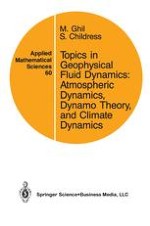The vigorous stirring of a cup of tea gives rise, as we all know, to interesting fluid dynamical phenomena, some of which are very hard to explain. In this book our "cup of tea" contains the currents of the Earth's atmosphere, oceans, mantle, and fluid core. Our goal is to under stand the basic physical processes which are most important in describing what we observe, directly or indirectly, in these complex systems. While in many respects our understanding is measured by the ability to predict, the focus here will be on relatively simple models which can aid our physical intuition by suggesting useful mathematical methods of investiga tion. These elementary models can be viewed as part of a hierarchy of models of increasing complexity, moving toward those which might be use fully predictive. The discussion in this book will deal primarily with the Earth. Interplanetary probes of Venus, Mars, Jupiter and Saturn have revealed many exciting phenomena which bear on geophysical fluid dynamics. They have also enabled us to see the effect of changing the values of certain parameters, such as gravity and rotation rate, on geophysical flows. On the other hand, satellite observations of our own planet on a daily and hourly basis have turned it into a unique laboratory for the study of fluid motions on a scale never dreamt of before: the motion of cyclones can be observed via satellite just as wing tip vortices are studied in a wind tunnel.
